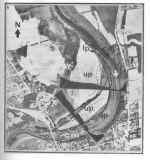|
1983.
M.Sc., 142
pp.
THE
EFFECT OF RIVER ICE ON A POINT BAR ON THE GRAND RIVER, ONTARIO
Lowden,
D.J.
 The
standard fluvial point bar model is characterised by a fining upward
progression of stratification types representing lateral accretion of the
point bar, followed by a vertically accreted sheet of essentially
structureless fine material. In cold regions the development of an ice cover
in fluvial and coastal systems is considered
to contribute to the sedimentological continuum of erosion,
transportation and deposition. In this thesis the erosional and depositional
capabilities of ice are considered for a point bar at Freeport, on the Grand
River. The
standard fluvial point bar model is characterised by a fining upward
progression of stratification types representing lateral accretion of the
point bar, followed by a vertically accreted sheet of essentially
structureless fine material. In cold regions the development of an ice cover
in fluvial and coastal systems is considered
to contribute to the sedimentological continuum of erosion,
transportation and deposition. In this thesis the erosional and depositional
capabilities of ice are considered for a point bar at Freeport, on the Grand
River.
The point bar is comprised of
distinct physiographic units; the channel margin, the swale, the lower point
bar and the upper point bar. In February 1981, an estimated 3S,333 m3
of ice accumulated following an ice drive, over the lower point bar. During
the ice emplacement, a variety of indirect and direct ice erosion features
were generated. These included a channel margin bench, ice impact scours,
hollows formed by the refloating of stranded ice blocks, and indentations
associated with the loading of ice blocks onto the substratum. The ice
transported 319 m3 of sediment onto the point bar. Silts and clays
are found intermixed with the ice, and are believed to be incorporated during
the ice formation period from suspended sediment loads. A wide range of grain
sizes occur on the outside of the ice blocks. The ice becomes charged with
this material as it moves down- stream. As the ice rafted sediment is released
during melting, it undergoes some redistribution and sorting. This occurs
through melt- water flow from the ice, slumping and rolling of gravels, and in
situ redistribution on the ice surface. In the latter case, voids
within the ice trap the finer particles and pellet structures are formed.
The ice rafted sediments occur on the point bar as a juxtaposition of
convex sand piles, gravelly piles, a silty sand veneer and randomly disributed
pebbles.
Three facies are identified
within the point bar sedimentary sequence. At the base is the Lower Facies
consisting of a lenticular interstratification of sands and gravelly sands.
This facies corresponds to the lateral accretion of the point bar. The Swale
Facies locally overlies the Lower Facies and occur as a sequence of inter-
layered sands and muds. Both of these facies are in turn overlain by the Upper
Facies that is typically comprised of sandy silts. Textural inversions occur
within the latter facies as sand pockets and lenses, gravel lenses and
isolated pebbles. The Upper Facies corresponds to the vertically accreted unit
and includes ice rafted materials which occur as textural inversions.
The soils on the point bar mature
laterally from Regosols close I to the channel, Gleysols in the swale,
Brunisols at the lower point bar
to upper point bar boundary, to Luvisols over the remaining upper point
bar. The principal controlling factor over soil development is the continual
input of carbonates to the point bar by water and ice. Bioturbation is
pronounced throughout the sequence and disrupts the
primary structures in addition to forming secondary structures.
This type of point bar differs
from the standard point bar through the local geological and hydrological
parameter, the river ice regime and postdepositional alteration through soil
forming processes.
|